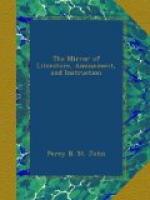Naturalists have much disputed the formation of pearls. Mr. Gray justly observes they are merely the internal nacred coat of the shell, which has been forced, by some extraneous cause, to assume a spherical form. Lister, on the other hand, states “a distemper in the creature produces them,” and compares them with calculi in the kidneys of man. But, as observed by a more recent inquirer,[12] “though they are accidental formations, and, of course, not always to be found in the shellfish which are known usually to contain them, still they are the products of a regular secretion, applied, however, in an unusual way, either to avert harm or allay irritation. That, in many instances they are formed by the oyster, to protect itself against aggression, is evident; for, with a plug of this nacred and solid material it shuts out worms and other intruders which have perforated the softer shell, and are intent on making prey of the hapless inmate: and it was apparently the knowledge of this fact that suggested to Linnaeus his method of producing pearls at pleasure, by puncturing the shell with a pointed wire. But this explanation accounts only for the origin of such pearls as are attached to the shell; while the best and greatest number, and, indeed, the only ones which can be strung, have no such attachment, and are formed in the body of the animal itself. ’The small and middling pearls,’ says Sir Alexander Johnston, ’are formed in the thickest part of the flesh of the oyster, near the union of the two shells; the large pearls almost loose in that part called the beard.’ Now, these may be the effect merely of an excess in the supply of calcareous matter, of which the oyster wishes to get rid; or, they may be formed by an effusion of pearl, to cover some irritating and extraneous body.” The reality of the latter theory is strengthened, if not proved by the Chinese forcing the swan muscle to make pearls by throwing into its shell, when open, five or six minute mother-of-pearl beads, which, being left for a year, are found covered with a crust perfectly resembling the real pearl. Such is one method of getting artificial pearls. The extraneous body which naturally serves for the nucleus, appears to be very often, or, as Sir E. Home says, always, a blighted ovum or egg. This theory which, however, is here but partly explained, has been fully adopted by Sir E. Home:—“if,” says the enthusiastic baronet, “I shall prove that this, the richest jewel in a monarch’s crown, which cannot be imitated by any art of man, either in the beauty of its form or the brilliancy and lustre produced by a central illuminated cell, is the abortive egg of an oyster enveloped in its own nacre, of which it receives annually a layer of increase during the life of the animal, who will not be struck with wonder and astonishment?” And, we must add, that the proofs are very much in favour of this conclusion.
[12] The writer of An Introduction
to the Natural History of
Molluscous Animals, in a Series of Letters:
one of the
most delightful contributions to the Magazine
of Natural
History, since the establishment of that
valuable
journal.




